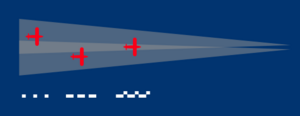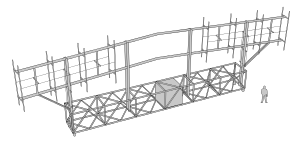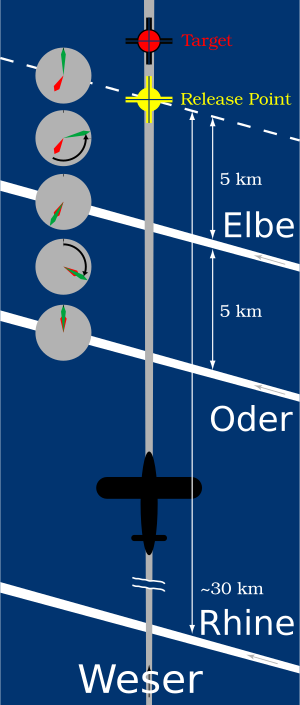Battle of the Beams facts for kids
The Battle of the Beams was a secret war of wits during World War II. It happened when German bombers used special radio signals to find their way at night over the United Kingdom. British scientists at the Air Ministry fought back with their own clever tricks. They used jamming and fake signals to confuse the German planes. This secret battle ended in May 1941. That's when Germany moved its forces to the East to prepare for an attack on the Soviet Union.
The idea of using "beams" for navigation started in the 1930s. It was first meant to help planes land safely in bad weather or at night. The basic idea is to send out two radio signals. These signals are aimed slightly to the left and right of a runway's center line. Pilots in the plane listen to these signals. They can tell if they are flying in the left beam or the right beam. Usually, Morse code signals are sent into the beams to tell them apart. For example, one beam might send "dots" and the other "dashes".
For bombing, the German Air Force (Luftwaffe) built huge versions of these antennas. This made the beams much more accurate over long distances. They called these systems Knickebein and X-Gerät. These were used effectively during the early part of "The Blitz". In one case, they dropped bombs perfectly along the center of a factory deep in England. British spies had learned about these systems before the war. So, the British fought back by sending their own Morse code signals. This made the German planes think they were on course, even when they were flying far off target. The Germans actually believed the British had found a way to bend radio signals!
When this problem became widespread, the Germans introduced a new system called Y-Gerät. The British had guessed what this system would be like from a small hint. They had already prepared ways to stop it. So, the Y-Gerät system became useless almost as soon as it was used. The Germans eventually gave up on using radio navigation over the UK. They thought the British would always find a way to jam their signals.
Contents
How Radio Beams Work
Before World War II began in 1939, German airlines like Lufthansa worked hard on making flying safer. They developed systems to help planes land at night or in bad weather. The main system they created was the Lorenz system. It was invented by Johannes Plendl. This system was being put into many civilian and military aircraft.
The Lorenz system used a special antenna with three parts. It sent out a radio signal that changed rapidly. The signal was sent to the middle part of the antenna. This antenna had two slightly longer reflector parts on each side. A fast switch turned each reflector on and off. This made the radio beam move slightly to the left and then slightly to the right of the runway's center line. The beams got wider as they moved away from the antennas. This created an area where the two signals overlapped.
A plane flying towards the airport would tune its radio to the Lorenz frequency. If the pilot was on the left side of the center line, they would hear short beeps (dots). This meant they needed to steer right to get back on course. If they were on the right side, they would hear long beeps (dashes). This meant they needed to steer left. When the plane was exactly in the middle, the radio would receive both signals. The dots would fill in the gaps of the dashes, making a continuous sound. This was called the "equisignal." By flying towards the runway and keeping this steady sound, pilots could guide their plane very accurately. They could even see the runway visually in most conditions.
Night Bombing Challenges
In the early 1930s, military leaders started thinking a lot about bombing at night. This was because new bombers could fly across Europe with lots of bombs. These planes were slow and easy targets for fighter planes during the day. But at night, the danger was much less. A black bomber was very hard to see. Also, flying higher and faster made it harder for ground defenses to hit them. Many believed that "the bomber will always get through" at night.
The main problem with night bombing was finding the target. It was very hard to see anything, especially a blacked-out city at night. Only very large targets, like whole cities, could be hit with any real chance of success.
The British Royal Air Force (RAF) trained their navigators very well. They put special domes on planes to let navigators use stars to find their way. This system seemed to work at first. But in reality, early British bombing raids often missed their targets by miles.
The German Luftwaffe had a different idea. They kept working on ways to bomb smaller targets accurately at night. Instead of using stars, they focused on radio navigation systems. They spent the 1930s developing a bombing system based on the Lorenz idea. This made night navigation much easier. Many German planes already had the radios needed for it.
The Lorenz system had a range of about 30 miles (48 km). This was enough for landing, but not for bombing raids over the UK. To fix this, they needed stronger transmitters and more sensitive receivers. Also, Lorenz beams were wide so planes could easily pick them up. But this meant they weren't very accurate over long distances. This wasn't a problem for landing, as the beams got narrower closer to the airport. But for bombing, it was the opposite. The system would be least accurate over the target.
German Beam Systems
Knickebein: The "Crooked Leg"
For bombing, the Germans made small changes to the Lorenz system. They needed much larger antennas to make the beams more accurate. These new antennas had many more parts. But they still used the simple switching method to slightly change the beam directions. The beams became so narrow that they were only a few tens of yards wide over the target. The unusual shape of these antennas gave the system its code name: Knickebein, which means "crooked leg." It's also the name of a magical raven in German stories. To reach long distances, the power of the transmitters was greatly increased. The Knickebein receivers in the planes looked like normal landing receivers.
A single Knickebein beam could guide bombers towards a target. But it couldn't tell them exactly when they were over it. To add this "when to drop" feature, a second transmitter was set up. Its beam would cross the first guidance beam exactly where the bombs should be dropped. The antennas could be turned to make the beams cross over the target. Bombers would fly along the first beam. When they started hearing the signals from the second beam (on a second radio), they knew they were at the right spot to drop their bombs.
The first Knickebein transmitters were set up in 1939 in Germany. One was on Stollberg hill near Denmark. Another was at Kleve near the Dutch border. A third was at Lörrach in southwestern Germany. After France fell in June 1940, more transmitters were built on the French coast. Stations were also built in Norway and the Netherlands.
Knickebein was used in the early German night bombing attacks. It worked quite well. However, the Germans hadn't fully developed how to use the system for large-scale bombing. So, much of their early night bombing was just hitting general areas.
Finding the Beams
It took time for Britain to stop the Knickebein system. British intelligence, led by R. V. Jones, learned about it. They found out when the Royal Aircraft Establishment studied a crashed German bomber's Lorenz system. They noticed it was much more sensitive than needed for just landing. Secret recordings of German prisoner pilots also hinted it was for bombing. Winston Churchill also received secret messages from Ultra (decoded Enigma messages) that mentioned "bombing beams."
When Jones told Churchill about the possible bombing beams, Churchill ordered more investigation. The British called the system "Headache." Many in the Air Ministry didn't believe the system was being used. Frederick Lindemann, a top science advisor, argued that such a system couldn't follow the curve of the Earth. But T. S. Eckersley of the Marconi company said it could.
Eckersley's idea was proven right after Churchill ordered a flight to find the beams. The RAF didn't have equipment to detect the 30–33 MHz Lorenz signals. So, they bought an American Hallicrafters S-27 amateur radio receiver from a shop in London. This receiver was put into an Avro Anson plane. A member of the Y Service operated it. The flight almost didn't happen when Eckersley changed his mind about the beams bending around the Earth. Jones saved the flight by reminding everyone that Churchill himself had ordered it.
The crew wasn't told many details. They were just told to look for radio signals around 30 MHz that sounded like Lorenz. If they found any, they had to figure out where they came from. The flight took off and eventually found the beam from Kleve, at 31.5 MHz. Then they found the cross beam from Stollberg. The radio operator and navigator mapped the beams. They found that the beams crossed exactly over the Rolls-Royce engine factory in Derby. At that time, it was the only factory making the important Merlin engine. They later realized that the argument about beams bending was not important. The transmitters were mostly in direct sight of bombers flying at high altitude.
Some British people still doubted the system. They thought it just showed German pilots weren't as good as British ones. But the Butt Report proved them wrong. Photos from aerial reconnaissance showed that RAF bombs rarely hit their targets.
Stopping the Beams
The British efforts to stop the Knickebein system were called "Aspirin." At first, they used modified medical diathermy machines to send out interference. Later, local radio transmitters sent out an extra "dot signal" at low power when raids were expected. The Germans helped the British by turning on their beams long before the bombers reached the target. Avro Anson planes with receivers would fly around Britain to find the beams. When a beam was found, nearby broadcasters were told to start jamming.
At first, the low-power "dot signal" was sent randomly. So, German navigators would hear two sets of dots. This created many "on course" areas, making it hard to tell which was the real one. Later, the British transmitters were changed to send their dots at the same time as the German ones. This made it impossible to tell which signal was which. Navigators would receive the "on course" signal over a wide area. This made it impossible to navigate accurately. Planes would drift off course into the "dash area" with no way to correct.
This made the beam seem "bent" away from the target. Eventually, the British could even bend the beams by a controlled amount. This allowed them to trick the Germans into dropping their bombs where the British wanted them. A funny side effect was that German crews were trained to navigate only by the beams. Many of them couldn't find the real "on course" signal or even Germany again. Some Luftwaffe bombers even landed at RAF bases, thinking they were back home!
X-Gerät: The Super Accurate System
Even though Knickebein was good, it wasn't designed for very long-range, super-accurate bombing. Plendl had been working on an even more precise version. This became X-Gerät (X-Apparatus). X-Gerät used several beams to find the target, each named after a river. The main beam, Weser, was like Knickebein but used a much higher radio frequency. This allowed its two beams to be aimed much more accurately from a similar-sized antenna. The "on course" area was only about 100 yards (91 m) wide at 200 miles (320 km) from the antenna. The beams were so narrow that bombers couldn't find them without help. So, a low-power, wide-beam Knickebein system was set up at the same station to guide them. The main Weser antenna was built west of Cherbourg in France.
The "cross" signals in X-Gerät used three very narrow single beams: Rhine, Oder, and Elbe. They were carefully aimed to mark a precise path for bomb release. First, they figured out the bomb release point along the Weser beam. This was done by calculating how far the bombs would travel after being dropped. The Elbe beam crossed Weser 5 km (3.1 mi) before the release point. The Oder beam crossed Weser 10 km (6.2 mi) before the release point, or 5 km (3.1 mi) before Elbe. Rhine didn't need to be as precise and was about 30 km (18.6 mi) before the release point.
As the bomber flew along the Weser beam and reached Rhine, the radio operator heard a short signal. He then set up a special stopwatch with two hands. When the Oder signal was received, the clock automatically started. Both hands swept up from zero. When the Elbe signal was received, one hand stopped. The other hand reversed, sweeping back towards zero. The stopped hand showed the exact time it took to travel from Oder to Elbe. Since the distance from Oder to Elbe was the same as from Elbe to the release point, the bombs were automatically dropped when the moving hand reached zero.
X-Gerät used a much higher frequency (around 60 MHz) than Knickebein. This meant new radio equipment was needed. Not all bombers had this new equipment. So, a special unit called Kampfgruppe 100 (KGr 100) was given the job of using their X-Gerät to guide other planes. KGr 100 planes would attack first in a small group. They would drop flares that other planes could then see and bomb visually. This was the first time the "pathfinder" idea was used. The RAF later used and improved this idea greatly against the Germans.
The system was first tested on December 20, 1939. A bomber from KGr 100 flew over London at 7,000 meters (23,000 ft).
X-Gerät was used very effectively in a series of raids the Germans called "Moonlight Sonata." These raids hit Coventry, Wolverhampton, and Birmingham. In the raid on Birmingham, only KGr 100 was used. British analysis after the raid showed that most bombs landed within 100 yards (91 m) of the Weser beam's center line. They were spread out for a few hundred yards along it. This was an accuracy that even daytime bombing rarely achieved. The raid on Coventry, with other units dropping bombs on the flares, almost destroyed the city center.
Stopping the Super Accurate System
X-Gerät was harder to stop than Knickebein. The first defenses against it were similar to those for Knickebein. They tried to disrupt the Coventry raid but failed. Although Jones had correctly guessed the beam layout, he had measured the signal's rhythm (modulation frequency) incorrectly. He thought it was 1,500 Hz, but it was actually 2,000 Hz. At the time, they thought this wouldn't matter much. They believed an operator in a noisy plane wouldn't notice the small difference.
The mystery was solved after an X-Gerät-equipped Heinkel He 111 plane crashed on November 6, 1940, on the English coast. Even though the plane sank during recovery, the waterlogged X-Gerät equipment was retrieved. When examined, they found a new device. This device automatically decoded the dots and dashes and moved a pointer on a display for the pilot. This device had a very sharp filter. It was sensitive only to 2,000 Hz, not the British 1,500 Hz counter-signals. The jammers were changed to 2,000 Hz. But this was too late for the Coventry raid on November 14. However, the modified jammers successfully disrupted a raid on Birmingham on November 19.
X-Gerät was eventually defeated in another way. The British created a "false Elbe" beam. This beam crossed the 'Weser' guide beam only 1 km (0.6 mi) after the Oder beam. This was much earlier than the expected 5 km (3.1 mi). Since the final bomb release steps were automatic, the clock would reverse too early. This made the bombs drop kilometers short of the target. Setting up this false beam was very difficult. The Germans, learning from their Knickebein mistakes, did not switch on the X-Gerät beams until the last possible moment. This made it much harder for the British to set up the "false Elbe" in time.
Y-Gerät: The Last German Effort
As the British slowly started winning the Battle of the Beams, they wondered what the next German system would be. Since the current German methods were useless, a completely new system would be needed. Jones believed that if they could defeat this new system quickly, the Germans might give up on the whole idea of radio navigation.
British listeners soon started getting secret information from Enigma decrypts. These messages talked about a new device called Y-Gerät, sometimes also called Wotan. Jones had noticed that the Germans used very descriptive code names. So, he asked a German language expert at Bletchley Park about the word Wotan. The expert realized Wotan referred to Wōden, a one-eyed god. This made Jones think it might be a single-beam navigation system. Jones agreed. He knew a single-beam system would need a way to measure distance. He thought it might work like a system described by Hans Mayer, an anti-Nazi German scientist. Mayer had provided a lot of information in what is now known as the Oslo Report.
Y-Gerät used a single narrow beam pointed over the target. It was similar to earlier beam systems and sent out a changing radio signal. The system used a special device on the plane called a transponder (FuG 28a). This transponder received the signal from the beam and immediately sent it back to the ground station. The ground station listened for the return signal. It compared the timing of its signal to the original signal. This accurately measured how long the signal took to travel. This told them the distance to the plane. Combined with the direction of the beam (adjusted for the strongest return signal), the bomber's exact position could be found. The bombers didn't have to follow the beam themselves. Instead, ground controllers calculated their position and gave radio instructions to the pilot to correct their flight path.
Jones later learned that his guess about the "Wotan" name was just luck. Later documents showed that the original X-Gerät was called Wotan I, and Y-Gerät was Wotan II. If he had known the name was also linked to X-Gerät, he probably wouldn't have guessed it was a single-beam system.
Stopping the Last System

The British were ready for this system even before it was used. By chance, the Germans had chosen a bad operating frequency for the Wotan system. It operated at 45 MHz. This happened to be the frequency of the powerful, but unused, BBC television transmitter at Alexandra Palace. All Jones had to do was arrange for the signal returning from the aircraft to be received and then sent to Alexandra Palace for re-transmission. The combination of the two signals changed the timing, and thus the apparent distance. At first, the signal was re-transmitted at low power. It wasn't strong enough for the Germans to realize what was happening. But it was enough to mess up the system's accuracy. Over the next few nights, the transmitter power was slowly increased.
As Y-Gerät continued to be used, the German aircrews blamed the ground station for sending bad signals. The ground station blamed the aircraft for having loose connections. This whole plan appealed to Jones because he loved practical jokes. He said he was able to play one of the biggest practical jokes using almost any national resource he needed. The slowly increasing power made the Germans think the system had natural problems, not that it was being interfered with. Eventually, as the power was increased enough, the whole Y-Gerät system started to "ring" with all the feedback.
The Luftwaffe finally realized that the British had been using countermeasures from the very first day the system was used. They completely lost faith in electronic navigation aids, just as the British had predicted. They didn't use any more such systems against Great Britain. By this time, however, Adolf Hitler's attention was turning towards Eastern Europe.
See also
- Belfast Blitz
- Chain Home
- GEE, an early RAF navigation system for night bombing
- Kammhuber Line
- List of World War II electronic warfare equipment
- Oboe, a later RAF night bomber navigation system launched in December 1941.





